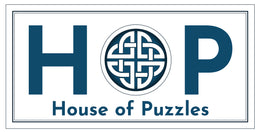Puzzles have been entertaining families for generations, but have you ever wondered how are jigsaw puzzles made?
Behind every puzzle lies a fascinating mix of creativity, precision, and craftsmanship. From selecting the right artwork to producing thousands of identical puzzle pieces, the journey from idea to finished puzzle is both technical and artistic. In this guide, we’ll walk you through the entire process of puzzle making and satisfy your curiosity!
1. Choosing the Puzzle Artwork

Image: Cider & Rosie BIG 500 Piece Jigsaw Puzzle
The first step in making a jigsaw puzzle is selecting the image. Popular choices include:
-
Landscapes and nature scenes: Relaxing and timeless.
-
Illustrations and artworks: Great for kids’ puzzles or themed collections.
-
Collages or patterns: Ideal for an extra challenge, great for seasoned puzzlers!
The image needs to be high-resolution so that it doesn’t lose quality when printed. Puzzle manufacturers also consider how engaging the image will be to assemble. Too much blank sky, for example, can make the puzzle frustrating.
Want to see how artists inspire puzzle design? Discover how artists like Keith Stapleton and Robert Barry bring beautiful scenes to life in our collections.
2. Printing the Image

Once the artwork is chosen, it’s printed on high-quality paper using offset printing. This ensures bright, sharp colours that will last. The printed sheet is then mounted onto a sturdy cardboard backing, which forms the base of the puzzle. The thickness of the board is carefully chosen so that pieces fit snugly together and can withstand repeated use.
The House of Puzzles jigsaw puzzle boards are made from premium quality FSC® Certified board, so our puzzles are as eco-friendly as possible whilst maintaining the high quality yo deserve. You can see this attention to quality in action with our Can I Help 1000 piece puzzle
3. Creating the Cutting Die

The real magic of puzzle making happens with the cutting die, a special tool that works like a giant cookie cutter. Here’s how it’s made:
-
A skilled die-maker bends razor-sharp steel rules into puzzle-piece shapes.
-
These blades are fixed into a wooden board to form the complete puzzle pattern.
-
Each puzzle design has its own die, meaning no two puzzles are cut exactly the same way.
This is what makes our unique jigsaw puzzles so distinctive; each cut style is carefully crafted for a satisfying fit.
4. Cutting the Puzzle

The mounted puzzle image and backing board are pressed against the die using a powerful press, cutting the sheet into hundreds (or sometimes thousands) of individual pieces. Manufacturers check for precision to make sure each piece cuts cleanly without tearing the image layer.
For children’s puzzles, fewer, larger pieces are cut, while jigsaw puzzles for adults can contain 1,000 pieces or more.
5. Quality Control

Before packaging, puzzles go through quality checks:
-
Print quality: Colours should be bright and accurate.
-
Cutting accuracy: Pieces must fit together smoothly.
- Piece count: Every puzzle must contain the exact number of pieces advertised.
This is what makes our unique jigsaw puzzles so distinctive, each cut style is carefully crafted for a satisfying fit.
6. Packaging the Puzzle

Finally, the puzzle pieces are mixed up, boxed, and sealed. Most boxes include a full-size image of the finished puzzle for reference. Eco-friendly manufacturers are increasingly moving away from plastic bags, instead using paper bags or recyclable cardboard inserts.
At The House of Puzzles, our packaging has undergone some adjustments recently, and we are now using glucose discs instead of plastic to secure our boxes. Using a glucose disc instead of a plastic adhesive disc is a more eco-friendly choice because it’s biodegradable, compostable, and made from natural materials. Unlike plastic, which can take hundreds of years to break down, glucose discs decompose safely without harming the environment, making them a sustainable solution for our packaging.
How long does it take to make a jigsaw puzzle?
From artwork selection to packaging, the process can take several weeks. Once the cutting die is ready, puzzles can be produced quickly in large batches.
Why Knowing How Jigsaw Puzzles Are Made Matters
Jigsaw puzzles are more than just a pastime; they’re the result of a detailed, fascinating production process. From the printing press to the cutting die, each stage is designed to deliver hours of fun and satisfaction.
So next time you sit down with your favourite puzzle, take a moment to appreciate the work that went into every piece!

